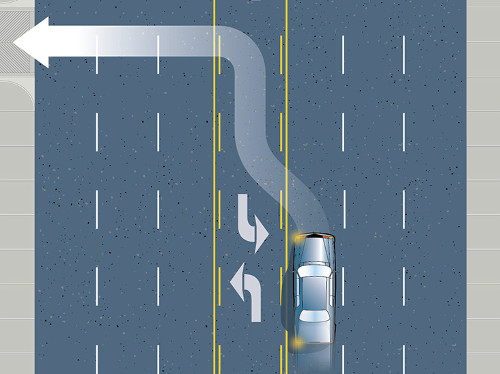 A two way left turn lane is often found in larger towns and cities running down the centre of multi-lane highway. It is easily identified by the combination solid and broken yellow line at both sides and the pair of opposing left pointing arrows painted on the road surface and displayed on black and white regulatory signs overhead.
A two way left turn lane is often found in larger towns and cities running down the centre of multi-lane highway. It is easily identified by the combination solid and broken yellow line at both sides and the pair of opposing left pointing arrows painted on the road surface and displayed on black and white regulatory signs overhead.
This lane may be a blessing for those who are turning left in heavy traffic, but it can make life difficult for those who wish to turn left and are entering the highway.
Two Way Left Turn Mid-Block
Two way left turn lanes can be handy for turning in the middle of the block. They provide a refuge outside of the usual traffic flow to wait patiently for a gap between oncoming vehicles and turn safely. It also acts to reduce the congestion caused by making left turns by moving turning vehicles out of through traffic.

The Lane Is Shared With Oncoming Traffic
Learn to Drive Smart mentions these lanes on page 38 and 51. This guide reminds us that when you use one of these lanes vehicles coming from the other direction also use this lane to turn left. It is wise to spend the shortest time and distance in them as is practical to accomplish your turn.
Some jurisdictions limit the distance that you are allowed to drive in a two way left turn lane.
You Must Turn Left to Leave This Lane
You cannot enter and travel along the two way left turn lane unless you intend to turn left to leave it. Obviously, this means that these lanes must not be used to pass overtaken traffic.
It also means that if you are trying to enter a highway with a two way left turn lane by turning left onto it, you have an extra 3.5 meters or so to go, putting you at risk for a longer distance. You must travel completely across the through lanes that are coming from your left as well as the two way left turn lane before turning left to enter the first lane available for through traffic.

Too Dangerous to Turn Left?
It is farther to go, but if you are able to use a cross street with a traffic light this will safely extend your decision time and may remove a number of lanes of cross traffic from your decision making process.
Use Your Signal Lights
One last thought, and that is the use of signal lights in this situation is mandatory. Tell everyone what your intention is before you do it!
Learn More
Share This Article
After pulling into the lane, an eastbound car entered the lane facing me. He wanted to turn left into a driveway behind me, and I wanted to turn left into a driveway behind him. Traffic was heavy enough in both directions that pulling back out of the lane into the through lanes was problematic for both of us.
What is the proper procedure here?
- Log in to post comments
One of you will have to turn left early to look at it from a staying within the law viewpoint. This is why it is important not to travel within the two way left turn lane for any longer than you need to.
Perhaps the driver that spent the most time in the lane should be the one to give way?
- Log in to post comments
Perhaps the driver that spent the most time in the lane should be the one to give way?
That could create havoc! Drivers would be getting in the double left turn lane asap then cruising along past various driveways (for them or potential oncoming vehicles) if they thought it gave them right of way!
Fact is, drivers should only move into that middle lane as late as reasonable to ensure they don't block oncoming vehicles. The main purpose of double-left turn lanes is to get the many vehicles that use it out of the way of through traffic, as this will usually be an arterial road, often in a business district.
If there's nobody behind, the smartest (and legal) option might be for one of them to back up a bit to allow the other to complete their maneuver.
- Log in to post comments
- Log in to post comments

What to Do?